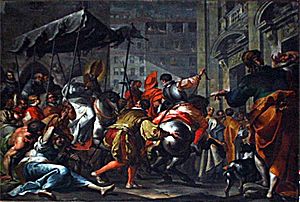Filippo Abbiati facts for kids

Filippo Abbiati (born 1640, died 1715) was a talented Italian painter. He lived during the early Baroque period. He worked mostly in areas like Lombardy and Turin.
Filippo Abbiati was an important artist from the School of Lombardy. He was known for his mannerist style. He studied with painters like Antonio Busca and Carlo Francesco Nuvolone. Later, Filippo Abbiati taught other artists, including Alessandro Magnasco, Pietro Maggi, and Giuseppe Rivola.
Contents
About Filippo Abbiati's Art
Filippo Abbiati learned from his teachers, especially Carlo Francesco Nuvolone. He liked to paint with a smooth style. He also enjoyed creating large, bright backgrounds in his artworks.
Influences on His Style
Abbiati was greatly influenced by earlier Lombardy painters. These included famous artists like Cerano, Morazzone, and Procaccini. As he grew older, he also learned from the Roman Baroque style. He even saw some early Rococo art.
He also connected with Venetian painters such as Federico Bencovich and Sebastiano Ricci. This connection influenced his own students.
Where Abbiati Worked
Filippo Abbiati created many paintings. Most of his work was done in and around Milan. We do not have much information about his daily life.
In 1671, he painted a canvas for a church in Milan. He also painted for a school in Venice. This suggests he might have visited Venice. Some people think he traveled to Rome before 1674. This could explain why Roman art influenced his painting of Blessed Tolomeo. This painting is in the San Vittore al Corpo church in Milan.
Paintings in Saronno
For the Sanctuary of the Beata Vergine dei Miracoli in Saronno, he painted an altarpiece. This piece, from 1677, shows St. John the Baptist Preaching. He might have worked on it with Luca Borromeo. He also painted a David there. In 1688, he painted The Gathering of the Manna for the same place.
Works in Milan and Novara
In 1680, Abbiati was asked to paint three canvases for the San Sebastiano church in Milan. His most famous works are the frescoes in the Sant'Alessandro church in Milan. He painted these from 1683 to 1696. He worked with Federico Bianchi on these.
It is hard to tell which parts each artist painted. However, some believe Abbiati painted The Triumph of the Holy Trinity in the dome. They also think he painted Scenes from the Life of Saint Alexander in the choir. Around the same time, he painted The Council of Ephesus for the Santa Maria del Carmine church. He also created 31 paintings about the life of Saint Lawrence for the Novara Cathedral.
Later Works
In 1700, Abbiati received money for his work on funeral ceremonies. These were held to honor Emperor Charles II. Around that year, he painted for the Sant'Antonio church. These paintings included The Life of Sant'Andrea Avellino and Sant'Antonio Converts a Heretic. He also painted The Saint Peter Martyr Unmasks a False Madonna and The Miracle of the Mule. The last two paintings are now in the Diocesan Museum of Milan.
We do not have many records of his work in his final years. Filippo Abbiati passed away in Milan.
Famous Artworks
- The Solemn Entrance of Charles Borromeo in Milan (1670–80), part of the Quadroni of St. Charles at Milan Cathedral
- Portrait of Filippo Pirogalli (around 1677), found in Milan, Ospedale Maggiore
- Birth of Mary (around 1680), located in Santa Maria dei Miracoli Basilica, Morbio Inferiore, Switzerland
- Apparition of the Virgin (1683–85), at the musée Calvet, Avignon
- Self-Portrait, displayed at the Pinacoteca di Brera, Milan
- History of St Andrea of Avellino, at Sant'Antonio Abate, Milan
- Apparition of Virgin to Pope Honorius III, in the Church of Santa Maria del Carmine, Pavia
- San Siro before the Pope, at Pavia Cathedral
- David, Moses at Sant'Agostino, Pavia
- St John Preaching in the Wilderness, in a church in Saronno
Other works by Abbiati can be seen at the Pinacoteca Carrara in Bergamo. You can also find his art at the Biblioteca Ambrosiana in Milan.
See also
 In Spanish: Filippo Abbiati para niños
In Spanish: Filippo Abbiati para niños

